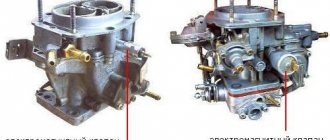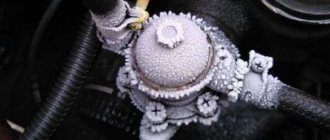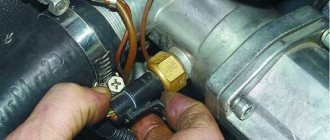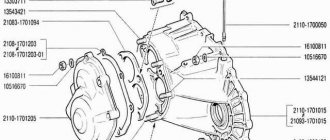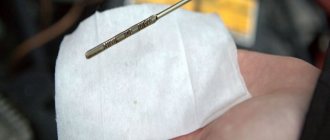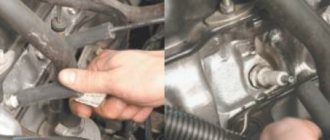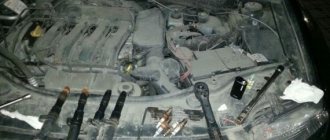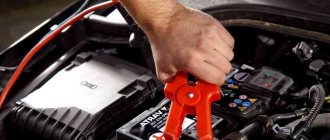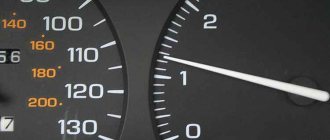Why does the engine troit?
At first glance, the causes of the problem lay on the surface: either there is nothing to burn in the cylinder, or there is nothing to ignite the working mixture. However, this is only at first glance. In fact, it can be very difficult to understand why the engine suddenly began to stall during startup or acceleration, and searching for the “root of evil” can take more than one day, especially in garage conditions.
It is important to pay attention under what conditions the engine does not pull when it starts to rev more strongly: when cold or after warming up, when driving under load or at idle, at low or high speeds, during acceleration or during uniform movement. Any little thing, often seemingly irrelevant, can be a clue.
So, why does the engine stall? The main reasons causing this malfunction are as follows:
- incorrect ignition timing;
- suction of atmospheric air in the vacuum brake booster;
- faulty spark plugs (the most common cause);
- broken high-voltage wires;
- faulty capacitor;
- air leak in the intake manifold;
- burnout of valves or pistons;
- broken, worn or deformed piston rings;
- violation of valve timing;
- severely worn valve rockers;
- burnout or breakdown of the cylinder head gasket;
- worn valve stem seals (hardened, pierced or completely destroyed);
- incorrectly adjusted carburetor;
- worn distributor-distributor shaft or rotary plate bearing;
- clogged air filter;
- loss of tightness due to deformation or wear of the membrane of the vacuum ignition timing regulator;
- the use of spark plugs that are not suitable in their parameters for this engine.
Reasons why the engine stalls
If there is a suspicion that the engine is malfunctioning, then it is necessary to diagnose the power unit. In the list of the most common causes of tripping, experts and experienced car enthusiasts highlight the following:
- ignition system;
- mixture formation and nutrition system;
- problems with timing belt;
- electronic control system;
- internal combustion engine malfunctions;
Let us immediately note that there are many reasons, and without proper experience in diagnostics, it is not always possible to quickly and accurately identify the problem. For this reason, below we will dwell on the most common malfunctions that most drivers can fix with their own hands, as well as characteristic signs indicating a particular problem.
Engine troubles: ignition system problems
One of the most common causes of engine tripping is problems in the ignition system or incorrect ignition settings. If you listen to the operation of the motor, in this case you can determine if one of the strokes is missing, and popping noises may appear, which are accompanied by twitching of the engine.
If such operation is noted at idle speed, but after spinning the crankshaft the engine begins to run smoothly, the cause may be early ignition. This indicates the need to adjust and configure the ignition on many cars.
Let's move on. If everything is in order with the settings, then you need to move on to checking the spark plugs. Note that about 50% of all cases when the engine fails are associated with spark plugs. The best option would be to completely replace all spark plugs with new ones or known good ones.
In this case, you should select the spark plugs correctly, that is, for a specific engine (according to the heat rating and a number of other important parameters). If it is not possible to replace the spark plugs, then you should clean the existing ones, and also check the gap between the electrodes and adjust the gap on the spark plug if necessary.
Also, we should not forget that parallel to the spark plugs, high-voltage spark plug armored wires often fail. The result is that the spark may break through and not reach the spark plug. High-voltage wires need to be checked and promptly changed if necessary.
If the engine stalls after washing the car or in wet weather, this is often a sign of problems with the explosives. To check, you can start the engine in the dark, after which the high-voltage wires are carefully inspected.
The appearance of a spark will clearly indicate a breakdown of the wire insulation or other problems. For a temporary solution, you can wrap the damaged area with electrical tape, after which one wire or the entire set should be replaced as soon as possible.
Currently reading:
External cleaner for oil and other contaminants from the engine...
Sep 6, 2020
Resource of modern engines
Sep 5, 2020
We also note that on different cars the distributor or ignition coils may require attention. By the way, in the second case, the engine can only start when it’s hot, while working normally until it warms up. The fact is that the coils can fail even when the internal combustion engine reaches operating temperatures, but misfires still occur.
Violation of mixture formation and fuel supply
Now let's imagine that there is a spark on the candles, but the engine still stalls. This means that fuel is not supplied to the cylinders or the mixture of fuel and air does not ignite. As you know, fuel must be mixed with air in strictly defined proportions. Increasing the amount of fuel results in a richer mixture, while increasing the amount of air means a leaner mixture.
Both too “lean” and too “rich” mixtures lose their ability to ignite from a spark. In such a situation, the engine often stalls both cold and hot, at idle and under load. The cause of the tripping in this case may be a dirty air filter. To put it simply, the engine does not have enough air, the mixture becomes very rich, and the spark plugs are filled with gasoline.
If we talk about problems with the fuel system, fuel may either not be supplied in the required quantity, or it may be supplied in excess. For example, in cases where the injectors of an injection engine are “overflowing” a lot. In such a situation, it is necessary to check the injector separately.
We also note that the engine often stalls if there is an air leak in the fuel supply system or at the intake. In either case, the excess air causes the mixture to become lean. Also, many cars have problems with the vacuum brake booster, and such problems also “air” the system.
It should be added that the quality of the mixture, depending on the engine operating mode on modern cars, directly depends on the ECM. This system is installed on engines with electronic injection and includes a control unit (ECU), to which various sensors are connected (mass air flow sensor, air sensing sensor, air pressure sensor, etc.)
The controller also controls actuators (for example, IAC), which allows you to regulate mixture formation, automatically control and dynamically adjust the operation of the motor.
It is quite obvious that failure of individual sensors or system components will lead to failures. A common result is that the engine in this case does not start well, runs unstably, stalls, smokes, consumes too much fuel, does not pull, etc. To accurately determine the problem, it is recommended to start with computer diagnostics of the engine and reading errors from the ECU memory.
Troubleshooting and problems with the engine itself
For normal operation of the engine and the most efficient combustion of the fuel and air mixture, the cylinder must be hermetically closed at the right moments (cycles). If certain damage to the CPG and timing belt occurs inside the engine, malfunctions occur in the gas distribution mechanism, etc., then naturally one should expect a leak in the seal.
In simple words, the piston will not be able to properly compress the mixture in the cylinder for subsequent ignition. As a rule, the loss of tightness is caused by the occurrence or destruction of piston rings, damage to the piston, deep scuffs on the cylinder surface or cracks, burnt-out timing valves, etc.
To determine the problem, at the initial stage it is necessary to measure the compression in the engine cylinders. If only in one cylinder the indicator has dropped below normal, then you need to pour a little engine oil into this cylinder through a syringe. Then precise compression measurements are repeated. If the compression has risen, this will indicate that the problem is most likely related to the piston. If no changes are detected after adding oil, then there is a high probability of valve burnout.
We also recommend reading the article about why a diesel engine stalls. From this article you will learn about the main causes of diesel engine tripping, as well as diagnostic methods for troubleshooting and troubleshooting.
We also note that a decrease in compression and loss of tightness in the cylinders can also be caused by incorrectly adjusted valves (adjusting the thermal clearance of the valves), as well as wear of the rocker (pusher) or problems with hydraulic compensators. The result of such problems is a loose fit of the valve to the seat. It should also be remembered that in some cases you should not forget about general timing adjustments, since the valve timing must be set correctly.
Finding a broken cylinder
This task is not difficult. The only thing that needs to be done is to disconnect the tips of the high-voltage wires from the spark plugs one by one with the engine running. If you disconnect the working cylinder in this way, the sound of the motor will change, but if after disconnecting the tip the sound remains the same, it means that a non-working cylinder has been found.
When disconnecting high-voltage wires, you must be careful because the risk of electric shock is very high. This is not fatal, of course, but very unpleasant. First, you need to place a dielectric material under your feet, such as a dry board or rubber mat. Secondly, you need to disconnect it by holding the wire itself, and not the cap. Thirdly, you must not touch the car body during the procedure.
A detailed analysis of the reasons for engine tripping
Although a tripping motor exhibits the same symptoms every time, it is much easier to solve the problem if you know the specific causes of this phenomenon. The main reasons causing the failure of one or more engine cylinders were listed above. Because of them, the engine does not pull at high speeds, it trots strongly at low speeds, during startup or acceleration, after warming up or when cold. Let's take a closer look at them.
Incorrect ignition timing
If the engine stalls for this reason, then a kind of clapping sound is heard, during which the engine jumps. To accurately determine this malfunction, you need to listen to the engine at low speeds, since at high speeds its operation is leveled out, and skipping cycles becomes unnoticeable. As a rule, the above signs indicate excessively early ignition. This is confirmed by the jerks that the engine makes when cranked by the starter.
Intake of atmospheric air in the vacuum brake booster
If the car has a vacuum brake booster, air leaks occur when the diaphragm, hose or valve is damaged. Excess air appears in the system, which mixes with the working mixture, depleting it. As a result, the mixture in the cylinder may not always ignite. The spark plug, in turn, gets wet and cannot form a normal spark that can ignite the air-fuel mixture. This malfunction is quite difficult to identify, since there is no special equipment capable of determining exactly where the seal of the vacuum booster system is broken.
Faulty spark plug
An accompanying symptom that confirms the hypothesis that the cause is the spark plug is the fact that a cold engine trots more strongly. After warming up, the problem often disappears or becomes less pronounced.
First of all, you should pay attention to the color of the central electrode insulator. Determining a normally working spark plug is not difficult. A normal insulator is light or slightly brownish. If the color of the insulator is different from normal, then you need to find out why. Traces of oil or carbon deposits on the insulator indicate that an over-enriched mixture is entering the cylinder, which floods the spark plug, or it is “filled” with oil. As a result, normal sparking is disrupted.
The reasons for this may be different:
- the engine idles a lot when warming up;
- the check valve of the power supply system is faulty;
- low compression in the cylinder;
- impaired valve timing;
- malfunctions in the operation of injectors;
- failure of the oxygen sensor.
The engine stalls when hot: causes and solutions
Some drivers have noticed that after warming up, the engine begins to stall, that is, its power drops due to a malfunction of one of the internal combustion engine cylinders. In addition to a noticeable deterioration in speed characteristics, as the speed increases, you can notice body vibrations, a large variable amount and fuel consumption of idle speed.
You need to find out where this trouble comes from and how to solve it.
About engine tripping
The term “troit engine” appeared in the Russian language at a time when citizens began to use cars with a 4-cylinder engine. If any of the 4 cylinders stopped working properly, they said that the engine was failing.
At the moment, the same designation is also used for 6- and 12-cylinder internal combustion engine models, despite the fact that this is not an entirely correct designation of the malfunction.
The highlight of the problem is that it is revealed only after the engine has started and the parts have become very hot.
During warming up, internal parts will be able to change sizes and their characteristics, which is why damage occurs during movement. Because 1 cylinder is malfunctioning, driving over short distances becomes unforgettable: vibration of the body in the first 2-60 seconds will already prove that the car is not capable of moving.
But triplicity may disappear, only to appear again after that.
Spark plug
The main thing is that it is forbidden to immediately find out why one of the cylinders failed. Just based on this, in addition, drivers and experienced car enthusiasts with experience will be able to delve into the insides of their own car all day, so they will not achieve any result at the finish line.
You have to control everything several times.
How can you speed up this procedure and pay attention to the most important troubles? Much more often the engine stalls just when warming up due to faulty spark plugs.
One of the circumstances of the malfunction is spark plugs, if:
- the insulation and contacts of the spark plugs are covered with oil or dark soot.
- The spark plugs or their contacts are damaged.
The trouble is as follows:
- excess oil enters the combustion chamber from the crankcase;
- the air-fuel mixture located in the combustion chamber does not ignite due to a faulty spark plug.
The solution to the problem is obvious: you need to replace the whole set of spark plugs, and then check the other parts next to them for damage. Change the oil and start the engine.
If the tripping is over, then everything was done correctly; if not, you need to look for other sources of trouble.
Possible options for trouble
Further searching for the cause of the problem becomes more difficult, because you will need to check a dozen details for the presence of damage:
- Additional air leaks into the combustion chamber appear; it is necessary to check the hoses and wiring.
- There is a breakdown somewhere in the wiring, go check their insulation for damage.
- Trouble with capacitors - check, replace if they are faulty.
- Inspect the valves for burnouts.
- Then you need to start inspecting their rings and pistons. If there are broken rings, burnt pistons, there may be trouble in them.
This is all that needs to be examined first. Then go through and inspect the following parts for defects: carburetor, valve stem seals, valve rockers, air filter, entire ignition system, cylinder head gasket.
If it goes back to warm after a detailed inspection of all replacement parts and parts of all damaged components, then you need to contact the service station for computer diagnostics of the car and the help of specialists. The cause of the malfunction is very difficult to find, therefore, in addition, finding it may take not a couple of hours, but a couple of days.
In rare cases, a trip to the service center may end in nothing.
How to check the wiring?
There is one, rather risky, method to find the three-cylinder cylinder: disconnect the high-voltage cables from the working engine one by one. By disconnecting the power from the ignition, it will be possible to realize which of the cylinders is not working, thereby significantly narrowing the search range.
But there is a risk of electric shock. It is not fatal, but it is quite painful, so you need to take care of your own protection.
It is possible to begin work if you first put on rubber gloves and climb onto a rubber mat. Then follow these tips:
- Turn on the engine, raise and secure the hood.
- One by one, you need to disconnect the cables from the spark plugs. You need to hold on to the insulation, not the tip of the wiring; you must not touch the body while removing the live wiring.
- If you turn off the slave cylinder, you will hear that the sound of the engine running has changed. But if it is faulty, then nothing will happen.
Once the approximate location has been identified, you need to go through all the details that are associated with this cylinder. Damage may also result from a small breakdown of the hose or peeling of the insulation on the wiring.
It is recommended to check the entire set:
- ignition;
- gas distribution (in such cases, something does not necessarily have to heat up);
- fuel - check the hoses.
List of probable troubles
Trouble. After refueling with new gasoline, the check engine light started to come on, the car managed to warm up, but it started to stall after about 20-30 60 seconds of driving. Answer. In this case, it is not the ignition, gas distribution and power supply system that can also be discarded.
It is necessary to check the integrity of the carburetor and the fuel supply system. Replacing gasoline from time to time does not solve the problem.
This happens in some foreign cars with automatic transmissions. If you couldn’t find anything on your own, go to a service station; computer diagnostics should be able to recognize the problem.
There is no need to simply agree to replacing components, if the option will only probably solve the problem. It is recommended to visit a second service station.
Trouble. Gasoline engine, injection type, misfires are shown in various cylinders during diagnostics. The spark plugs were replaced, all parts of the gas distribution system were cleaned and checked. Answer.
The breakdown may be in the distributor cover or the ignition power supply: wiring, coils. It remains to check the fuel system.
Engine tripping is a very unpleasant drawback that is difficult to get rid of. It is necessary to check all the components listed above, replace damaged parts - perhaps this will solve the problem.
If all attempts are in vain, then go to the service station for diagnostics.
Troubles the engine. The main circumstances!
Similar articles selected for you:
- Diesel engine stalls when hot: reasons
- Trouble with VAZ 2107 engine carburetor: description, causes and solutions
- Trouble with UMZ 4216 Euro 3 Gazelle engine: causes and solutions
- Troubles the 16-valve VAZ 2110 engine: reasons
What to do first if the engine seizes up
Summarizing all of the above, we can draw up small instructions on what to do if symptoms of a throbbing engine appear.
If the engine shakes more when starting or when cold, you need to start your search by checking the spark plugs and high-voltage wires. If the problem becomes more pronounced after warming up or under load, it is better to first check the condition of the air filter.
It is better to check other possible reasons as the work becomes more complex. » alt=»»>
Why does the engine stall? It is of great importance to determine the conditions that cause disturbances in engine operation. This can happen at idle, low, and also at high speeds, a cold and warm engine, driving under load, acceleration and a smooth ride. The condition for the occurrence of tripling may be any of the mentioned factors.
Trouble engine: signs
First of all, it is important to diagnose the malfunction in a timely manner, after which the problem is localized for repair. As for the motor tripping, you need to know the main signs of this problem, as well as why the engine is tripping (the reasons why the motor is tripping).
So, let's start with the fact that tripling actually means a malfunction of one or more cylinders. In other words, the working mixture of fuel and air, for one reason or another, does not ignite in the combustion chamber, ignites with a delay, does not burn completely, etc.
The main symptoms and signs of triplet are as follows:
- When the internal combustion engine is running in idle mode, malfunctions appear in the form of shaking and twitching of the engine. In some cases, vibrations can be quite strong and are transmitted to the body, steering wheel, and gearshift lever. If in the first case the problem can only appear periodically, in the second we can already talk about a complete failure of one or more cylinders.
- The engine noticeably loses power when driving, dips may occur when you press the gas, acceleration is accompanied by jerks, and fuel consumption increases. In some cases, the check engine light appears on the dashboard. Note that these symptoms can also arise for other reasons, but triplet also manifests itself in a similar way.
- The engine speed “jumps” or floats at XX, under load. Fluctuations can be either slight (850-1000 rpm) or strong (from 850 to 1500 rpm).
- When examining spark plugs, you can observe that the spark plug electrodes are covered with black soot. In this case, you should not be 100% sure that the spark plug is the culprit of the problem. The fact is that even after replacing a set of spark plugs, carbon deposits will appear again after a short period of time, since the main causes of tripping have not been eliminated.
- If you evaluate the sound of the exhaust from an engine that has begun to rev, instead of the rhythmic operation of the exhaust system, sound “jerks” can be clearly heard, which are also accompanied by increased vibrations in the body.
It is quite obvious that if even one of the listed symptoms appears, it is necessary to determine as quickly as possible whether the engine is malfunctioning due to internal combustion engine problems, equipment malfunctions, etc. The fact is that often ignoring even minor tripping in a fairly short period of time can cause more serious engine breakdowns, the elimination of which will require expensive and complex repairs.
Article on the topic: Basics of road safety for dummies
Description of signs and causes of engine tripping
Car owners of cars of various models often experience problems with the engine, among them there is such a type of defect as engine tripping (missing). A malfunction in the functioning of one of the four cylinders is what the engine is experiencing.
Only if you have experience and certain knowledge about the internal structure and operating principle of gasoline carburetor and injection internal combustion engines (ICE), can you determine the reason for the malfunction of the engine.
What is engine “triple”? This term appeared due to the four-cylinder design of the internal combustion engine, because when one cylinder fails, three working elements remain. The appearance of six-cylinder and twelve-cylinder engines did not change the existing terminology for defining this defect, contrary to the requirements of the Russian language.
Signs indicating a missing engine
You can find out what is wrong with the engine by examining the following signals:
- increased vibration of the engine - this means that the engine is shaking at idle or at low speeds;
- change in the color of the spark plugs, they become dark, covered with soot and carbon deposits;
- a characteristic exhaust sound indicates that some engine cylinder has lost its function and the engine is running rough;
- the appearance of thick white, black smoke from the exhaust pipe;
- there is not enough strength to accelerate the car;
- increase in gasoline consumption;
- the check blinks, indicating unstable speed;
- increased intermittent shocks during acceleration, as well as during uniform movement.
A certain sound of an altered stroke in a running engine can also be a consequence of the fact that this is causing the engine to throttle.
The symptoms that occur at low speeds, at high speeds and at idle are similar. How to find out the real reason? If the engine revs intensely at high and also at medium speeds, it means that the valves that allow the gap to increase when the engine reaches operating temperature are faulty. If it throttles at low speeds, the valve clearance increases until it warms up, and then restores.
Causes of cylinder failure
The appearance of missing is caused by the following factors:
- failure to adjust the ignition start;
- air intake in the brake system;
- accumulation of carbon deposits and breakdown of spark plugs;
- the integrity of the electrical wire leading to the spark plugs is broken;
- the appearance of malfunctions in the capacitor;
- violation of the integrity of the intake manifold;
- piston valve wear;
- the piston rings have become unusable;
- failure to adjust the gas distributor valves;
- violation of the integrity of the gaskets in the fuel pump head;
- wear of oil seals;
- adjustments in the carburetor are broken;
- air filter clogged;
- violation of the vacuum membrane of the advance regulator;
Inconsistency between the spark plug sizes and this type of engine can cause serious malfunctions in its operation.
When a cylinder stops functioning, the engine fails, the reasons that caused this defect entail a loss of power of the power unit, an increase in fuel consumption, and a malfunction of all vehicle systems.
How to determine which cylinder has failed
To determine a blocked cylinder, carry out the following steps:
- Disconnect the ends of the high-voltage wire from each spark plug one by one.
- Record the change in sounds in the operation of the engine with the spark plugs turned off; the previous sound indicates that the inactive cylinder has been turned off; we can conclude that this particular element has failed.
When disconnecting explosive wires, an electric shock may occur. To avoid injury, it is necessary to use a dielectric material in the form of a rubber mat or a dried wooden platform under your feet. When disconnecting, you need to grab the wire, but not the cap, and you cannot touch the car body.
How to determine if the engine is stalling when cold?
The engine may stall when cold and after it has warmed up. Why this happens and what malfunctions contribute to this will be discussed below. First, you need to determine the cause of the peculiar sound of the engine. Is this a consequence of this malfunction or a different reason.
First of all , listen to the exhaust sound
. It should be constant, without jerks or breaks.
You can also determine which cylinder has failed. For this:
- Open the hood and start the power unit;
- Listen to the sound and try to remember it;
- Now pull out the high-voltage wires one by one and watch the changing sound. When the cable is disconnected, the cylinder is switched off. Therefore, if the sound changes, then the cylinder is working. This will help you find the faulty cylinder.
Before checking and changing everything, think about the fact that “blind” diagnostics are not the best option, especially for a modern engine. There are too many similar symptoms for different breakdowns.
Therefore, first of all, it is better to do computer diagnostics, which will be carried out efficiently in car services in Moscow, and based on the results obtained, make appropriate conclusions in search of the source of the malfunction.
Conclusions obtained after diagnostics
When carrying out a thorough diagnosis, special attention must be paid to the appearance of the spark plugs. The presence of the following signs is unacceptable:
- carbon deposits;
- destruction of insulators;
- worn caps;
- failure of explosive wires;
- switch failure;
- The ignition coils have failed.
If an insufficient amount of fuel is poured into the cylinder, it means that the parts and components of the fuel pump are faulty. Increased fuel supply indicates that the fuel injectors are dirty and have become unusable. Impaired settings of the electronic control unit are also the cause of the engine shaking.
Such situations are often observed, as a result of which the engine can also trip:
- air filter contamination;
- throttle valve wear;
- Air flow sensor malfunction.
The lack of engine compression or its low level is the most difficult defect. This type of engine failure can indicate the following facts:
- burnout of pistons;
- valve failure;
- complete wear of the piston rings.
The car owner needs to determine why the engine is stalling and what to do next. It is necessary to seek professional help from the nearest service station, where qualified computer diagnostics of the car’s power unit will be carried out.
Possible reasons
There are quite a few potential faults, but most often the problems are caused by the same problems. Some are easy to handle with your own hands, others will require the involvement of specialists. Much depends on the type of engine and its design features. Failures often appear at a certain point in engine operation, which simplifies diagnosis.
Ignition system problems
This is one of the most common reasons, so you should start with it. Any failure in this system disrupts the normal functioning of the engine. Some faults will not be difficult to fix, but there are situations when it is better not to try to repair it yourself, so as not to cause even more damage.
Typical problems:
- Failures in ignition settings are a common cause of engine stalling. This can be determined by skipped strokes in one of the cylinders and characteristic popping noises in the manifold - they indicate that the fuel is not igniting when needed. The ignition may also be set too early; in this case, uneven operation is observed only at low speeds, and when you press the gas pedal, the engine starts to work normally. It is best to set the correct ignition timing from specialists, since this requires special equipment and certain knowledge.
- Spark plugs are the cause of failures in almost half of the cases, so they should be inspected. To do this, you need to disconnect the battery terminal and remove the high-voltage wires. It is important not to confuse them, so you can glue pieces of tape and write the cylinder number. In some models, for example VAZ 2114 and VAZ 2115, access to the spark plugs is good, in others you need a special key. After unscrewing, you need to inspect the working part: it should be light, without oil and soot. If there is a problem, it can be solved by replacing the entire set of spark plugs; you should not change them one by one.
- It is also worth checking the high-voltage wires: if they are broken, the motor will not work normally. At night, you can open the hood with the engine running: if there are even small sparks, the armored wires are to blame. To replace, you need to purchase a kit that matches your car model. Pay special attention to the contacts: you need to put them on as tightly as possible, but do not apply much force so as not to damage the connections.
- If you have an ignition distributor (distributor), there may be problems with it. There are many options - from a broken cover to burnt contacts or displacement of the unit due to a loose fastening. A poorly functioning ignition coil also causes tripping. In new models, a separate coil may be provided for each cylinder, which complicates diagnostics. In this case, problems often occur only when the engine is warm.
Important! Broken high-voltage wires can also be identified by observing that the car begins to malfunction only in damp weather or after washing.
It is best to start with spark plugs and wires, since this is a very common cause of the problem, and elimination takes a little time and is inexpensive. Setting up the ignition and diagnosing the distributor and coils is also cheap.
Mechanical engine failure
A more complex option if the engine is having problems due to problems with its components. Troubleshooting will require serious expenses; it is better to entrust repairs to specialists. The most common problems that arise are:
- Valve burnout. Replacing it is difficult, since to do this you need to remove the cylinder head. It is also possible that the valves are not adjusted correctly, causing them to not fit tightly in their seats.
- Another option is wear of the valve pushers or faulty hydraulic compensators (in this case, a characteristic clicking sound is heard, especially clearly visible at low speeds).
- Violation of the timing setting also leads to engine tripping. For example, if the belt jumped onto a tooth or was initially set incorrectly.
It is better to check all these problems in a workshop. Adjusting valves and timing requires certain qualifications, but if you find a detailed video for your car model, you can repair it yourself.
Fuel pump pressure
Another option that may cause the problem. In this case, the engine does not stall at idle speed when fuel consumption is low. But under load, interruptions in operation begin, since the pump cannot provide the required volume of fuel.
In this case, the car does not pull, if you sharply press the gas, failures in operation are often noticeable, which is especially unsafe when maneuvering on the road. The problem can only be solved by replacing the fuel pump; most often it is located in the tank and removed from the passenger compartment.
For your information! If an old VAZ stalls at high speeds, the reason may be a damaged membrane of the mechanical pump or wear of some of its components.
Intake tract leaking
If there is an air leak anywhere in this system, the engine will not operate normally. Therefore, it is worth checking all nodes to identify the problem. Most often it consists of the following:
- Burnout or wear of gaskets at the junction of individual elements, most often at the attachment to the cylinder head.
- Poor connection of parts. In this case, you need to tighten the bolts or clamps.
- Cracks in rubber corrugations or hoses are a typical problem for cars with high mileage. A visual inspection with partial disassembly will help. Sometimes it is enough to simply replace stretched clamps.
There may also be other reasons due to the design features of the motor. It is not difficult to replace gaskets and rubber elements yourself. Often the problem arises due to the fact that some hose simply fell off or was accidentally pulled off when servicing the car.
Incorrect operation of injectors
With the help of these elements, fuel is supplied to the cylinder in most modern gasoline and diesel engines. Due to proper atomization, the fuel ignites well and burns completely. If a VAZ or another model idles and twitches slightly when starting at low speeds, you need to check the injectors.
The reasons may be as follows:
- A malfunction of one of the elements, when it does not spray, but pours fuel, due to which it does not burn completely. As the engine warms up, the problem may disappear. It can be detected by diagnostics on a special stand.
- Loss of power supply to the injectors. Another option in which normal operation is impossible. It should be checked with measuring instruments.
- If one of the injectors is leaking, there may be a loss of pressure in the system. This is detected when starting the engine if you have to rotate the starter several times.
- It may turn out that the injector nozzles are clogged, which is why they do not supply the required amount of fuel and the engine begins to stall under load. In this case, cleaning or replacing the faulty unit will help.
For your information! The injectors may not deliver fuel properly due to a malfunction of the injection control unit or other control element.
It is better to entrust all work in case of such malfunctions to specialists, since it is better to diagnose problems using special equipment. Typically the cost is low and repairs take a few hours.
Compression in cylinders
When the engine wear is sufficiently large, the car can also suffer from the piston group. You can identify this malfunction yourself: just purchase a device for measuring compression, which is inexpensive.
Measurements are taken with the engine turned off and the spark plugs removed. The crankshaft is turned by the starter, and the values in each cylinder are measured separately. Normal values can be found in the model's instruction manual. Most often there are deviations in one of the cylinders, but if the car has a high mileage, the compression will be underestimated everywhere.
A little machine oil from a syringe is added to the cylinder with a deviation from the norm. If after this the indicators return to normal, the rings are most likely worn out or the cylinder is damaged. The problem can only be determined after removing the cylinder head.
Other reasons on certain models
There are a lot of electronics in the design of modern car models, which is why atypical problems occur. There are also unsuccessful design solutions that cause problems.
The most common cases:
- Failure or incorrect operation of the mass air flow sensor (MAF). It is installed on all modern engines and over time can provide incorrect data to the electronic engine control unit, which is why uneven operation is observed.
- The idle speed sensor, if present, may also fail. In this case, tripping is observed only at idle speed.
- If there are a lot of electronics, you can only determine which sensor is causing the motor to malfunction using a diagnostic program. It will show all the elements that are not working correctly.
- A clogged air filter does not provide the necessary air flow, which is why the fuel mixture is lean and the internal combustion engine operates intermittently. It is better to change it together with the oil filter.
- Poor contact of the ground wire with the body also often causes uneven engine operation, this is especially noticeable on a bad road. To eliminate the malfunction, you need to tighten the connections or clean the contact area if it is severely damaged by corrosion or the terminal is oxidized.
There may be other problems as many elements affect the operation of the motor. For example, the lambda probe in some models provokes engine vibration due to failures in the electronics. If your independent searches are unsuccessful, it is wiser to entrust the work to professionals.
Determining the causes of miss in gas engines
Car owners whose cars run on gas are faced with the problem of the engine tripping; the indicator light begins to flash. If the engine fails on gas, the reason is hidden in the following defects:
- Failure of gas filters; if necessary, they need to be replaced with new ones.
- The spark plugs have become unusable.
- Violation of the integrity of high-voltage wires.
- Incorrect settings, contamination of gas reducer filters.
- Wear of rubber gaskets in the gas reducer.
- Malfunctions in the functioning of gas injectors, leading to an increase in gas consumption and the appearance of engine detonation and tripping; after washing the injectors, measures to eliminate defects, and calibration, the missing goes away.
Vehicle owners should not neglect the alarming symptoms that appear, as they can become sources of major financial and temporary problems. It is necessary to conduct thorough scheduled and extraordinary computer diagnostics of the power unit in order to identify emerging defects in engine operation.
Many car owners may be faced with a situation where their car suddenly begins to pull poorly, and the engine is clearly running rough. Considering the fact that a modern internal combustion engine used in the automotive industry is a technically complex unit with many mechanical and electronic control systems, periodic malfunctions, especially without regular maintenance, can appear at the most unexpected moments. One of these is engine “tripleting” - in other words, one of the engine cylinders stops functioning completely or partially.
It is worth considering that this malfunction can occur for numerous reasons. At the same time, different models of power units and cars have their own characteristics that can lead to this. And we will look into the reasons and possible actions to eliminate them later in the article.
Symptoms of engine tripping
The most obvious signs of a problem are:
• Unstable operation of the power unit at idle and increased vibration. This is one of the main symptoms, but it does not warn of an imminent problem; it is already a consequence of the existing malfunction. In turn, this already leads to increased engine wear and increased fuel and oil consumption. Although the symptoms begin to appear gradually, when using the car every day, most car enthusiasts are not able to notice gradual changes in engine performance.
• The condition of the spark plugs is a good indicator of engine stability. If, when inspecting or replacing spark plugs, you notice a clear difference in one of them in color or carbon deposits that have appeared, then it will immediately become clear which cylinder has problems. In addition, even with long-term use of spark plugs, on a normally operating power unit, soot or deposits should not appear on the working part.
• A change in the engine sound or exhaust sound is another sign of a problem with the motor or engine misfire.
• Also, if one cylinder fails, the car significantly loses power and dynamics. But it should be borne in mind that a loss of power or dynamics is a sign of a serious malfunction, which may be deeper than the usual “triple”.
• Fuel consumption is also a good indicator of the normal operation of the power unit. If consumption has increased significantly, especially in a short time, this is a reason to start diagnosing the power unit or fuel system.
conclusions
You should not operate a car in which the engine misfires even occasionally; it is better to deal with the malfunction and eliminate the occurrence of more serious problems. You should start with the most common problems and check all systems using the method of elimination. Do not forget about the service life of spark plugs and high-voltage wires: they must be changed within the time limits established by the manufacturer.
You should also pay attention to fuel consumption - if even one of the cylinders is not working correctly, it will inevitably increase. Often the problem is a leak in the air supply system: rubber corrugations and hoses crack over time and require replacement.
